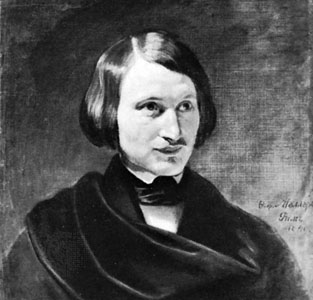 WHAT THEY TRADED: Nikolai Gogol
WHAT THEY TRADED: Nikolai Gogol
Upon his first arrival in St. Petersburg, Gogol was so overcome by the pleasures and perils of the city that he composed a volume of poetry addressing this beauty and splendor. It was his first contribution to the world of letters. Given Gogol's nature, it's not hard to imagine him having "big plans" for this particular work, imagining that it would immediately make him a "man about town" and someone "up and coming" to "keep an eye on."
Instead, his work was immediately savaged by the critics as the empty-headed fluff of a country bumpkin incapable of grasping that city life was ordinary and meaningless; just backdrop, just scenery. Gogol responded to his critics by buying up every single copy of his poetry and burning it, an act that consumed his entire inheritance and left him penniless.
But Gogol did not give up!
Years later, Gogol emerged from hiding with a number of short stories and the first part of a novel for sale called "Dead Souls." The first part of this novel made the critics eat their words about his earlier work. "Yes!" they said. "Here is true depravity and cynicism! Here is the bleak worldview we are looking for! Here it is what it means to be alive, alone, and miserable!"
The only problem was that this wasn't how Gogol saw life or his work at all. The critics branded Gogol as a downbeat satirist, as the kind of person who turned a high-powered microscope on the evils of society. But Gogol had intended "Dead Souls" to be the first half of a longer work. The first half would illustrate the downfall of a corrupted character, and the second half would show his redemption and ascension to virtue.
Thus, even in moderate success, Gogol was mocked and pursued -- forced to feel the grinding tension between the real and ideal. Still -- the critics clamored for the second half of his novel! They needed to hear the brave voice of the witty Mr. Gogol in their ears!
He delayed the second half of "Dead Souls" for years and years, but the public demanded that he finish his tale, so eventually he began work, knowing that his story was not what people wanted. Redemption and ascension to virtue are hardly popular topics for any age, but perhaps he would be the one to set things right?
NO: the first few chapters of the second half of "Dead Souls" were torn apart by the critics with even more savagery than even his old juvenile poetic efforts. Forced at last to face the revelation that the world of art cares nothing for joy and only wants to continuously satisfy its lust for misery and heartache, Gogol went mad.
He pushed all of his friends away and took refuge in an insane priest who wanted to found a new religion based entirely on Gogol's previous works, telling him that they were the sole cause of all the world's sins. You can find these people if you look hard enough for them and you are sufficiently a "man about town," "someone up and coming," and a person "to keep an eye on." The priest prescribed a steady diet of self-flagellation and gruel for Gogol to purge him of his wickedness.
One night, in a fit of feverish hallucination, "The Devil" visited Gogol and tricked him into burning his only manuscript of the second, uplifting half of "Dead Souls." The shock of the act aroused Gogol from his madness, only to find that his life's creative work had been destroyed by his own hands. There was no one to blame but himself.
He began to weep constantly, refused to eat, and died in extreme pain nine days later.
When the Soviets dug up Gogol's coffin in order to move the body and demolish the church around it, they found Gogol buried face down. This is often the sign that a person has been buried alive. When a person grows tired of screaming for help, they curl up and go to sleep -- done looking skyward.
Comment!
Posted by harlock on Thu, 10 Jul 2008 04:21:21 -0400 -- permanent link




